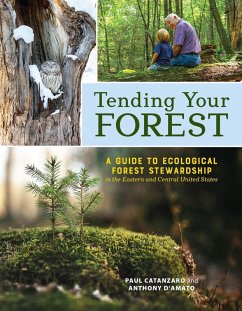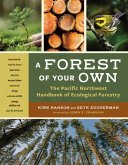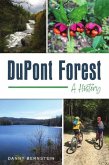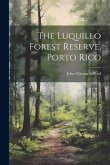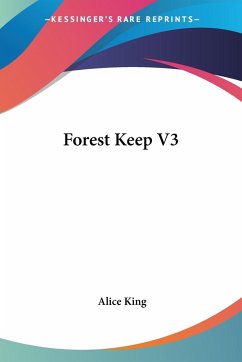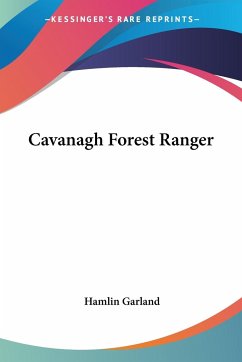Paul Catanzaro, Anthony D'Amato
Tending Your Forest
A Guide to Ecological Forest Stewardship in the Eastern and Central United States
22,99 €
inkl. MwSt.
Versandkostenfrei*
Erscheint vorauss. 17. März 2026
Melden Sie sich
hier
hier
für den Produktalarm an, um über die Verfügbarkeit des Produkts informiert zu werden.

11 °P sammeln
Paul Catanzaro, Anthony D'Amato
Tending Your Forest
A Guide to Ecological Forest Stewardship in the Eastern and Central United States
- Broschiertes Buch
How do you care for the health of your forest? This comprehensive guide empowers landowners with the knowledge of how to manage a family forest to capture more carbon, encourage wildlife and biodiversity, and build a more resilient future. Tending Your Forest brings a fresh, ecological perspective to forest management, providing landowners with the information they need to understand their forests and their options for stewarding them in the face of new challenges, such as climate change and invasive species. With the help of key professionals, landowners from Maine to Maryland and Missouri to…mehr
Andere Kunden interessierten sich auch für
![A Forest of Your Own A Forest of Your Own]() Kirk HansonA Forest of Your Own26,99 €
Kirk HansonA Forest of Your Own26,99 €![DuPont Forest DuPont Forest]() Danny BernsteinDuPont Forest17,99 €
Danny BernsteinDuPont Forest17,99 €![In the Great Apache Forest (Complete Edition) In the Great Apache Forest (Complete Edition)]() James Willard SchultzIn the Great Apache Forest (Complete Edition)8,49 €
James Willard SchultzIn the Great Apache Forest (Complete Edition)8,49 €![The Luquillo Forest Reserve, Porto Rico The Luquillo Forest Reserve, Porto Rico]() John Clayton GiffordThe Luquillo Forest Reserve, Porto Rico15,99 €
John Clayton GiffordThe Luquillo Forest Reserve, Porto Rico15,99 €![Forest Keep V3 Forest Keep V3]() Alice KingForest Keep V322,99 €
Alice KingForest Keep V322,99 €![In The Forest Of Arden In The Forest Of Arden]() Hamilton Wright MabieIn The Forest Of Arden15,99 €
Hamilton Wright MabieIn The Forest Of Arden15,99 €![Cavanagh Forest Ranger Cavanagh Forest Ranger]() Hamlin GarlandCavanagh Forest Ranger22,99 €
Hamlin GarlandCavanagh Forest Ranger22,99 €-
-
-
How do you care for the health of your forest? This comprehensive guide empowers landowners with the knowledge of how to manage a family forest to capture more carbon, encourage wildlife and biodiversity, and build a more resilient future. Tending Your Forest brings a fresh, ecological perspective to forest management, providing landowners with the information they need to understand their forests and their options for stewarding them in the face of new challenges, such as climate change and invasive species. With the help of key professionals, landowners from Maine to Maryland and Missouri to Minnesota can practice ecological forestry to achieve goals such as restoring old-growth characteristics, protecting wildlife and biodiversity, sequestering and storing carbon to mitigate climate change, preserving tree species at risk of extinction, and sustainably harvesting trees for local wood products. Finally, landowners will learn how to ensure their legacy by passing land on to their heirs and making use of conservation easements and other tools for protecting the land long into the future.
Produktdetails
- Produktdetails
- Verlag: Storey Publishing
- Seitenzahl: 276
- Erscheinungstermin: 17. März 2026
- Englisch
- Abmessung: 229mm x 178mm x 14mm
- Gewicht: 767g
- ISBN-13: 9781635868586
- ISBN-10: 1635868580
- Artikelnr.: 74904736
- Herstellerkennzeichnung
- Libri GmbH
- Europaallee 1
- 36244 Bad Hersfeld
- gpsr@libri.de
- Verlag: Storey Publishing
- Seitenzahl: 276
- Erscheinungstermin: 17. März 2026
- Englisch
- Abmessung: 229mm x 178mm x 14mm
- Gewicht: 767g
- ISBN-13: 9781635868586
- ISBN-10: 1635868580
- Artikelnr.: 74904736
- Herstellerkennzeichnung
- Libri GmbH
- Europaallee 1
- 36244 Bad Hersfeld
- gpsr@libri.de
Paul Catanzaro is a professor in the Forest Ecology and Conservation program at University of Massachusetts, where he teaches forest ecology, forest management, silviculture, and land protection. He is co-director of the Family Forest Research Center, a partnership of the USDA Forest Service and UMass. Catanzaro also serves as the state extension forester. For nearly 20 years, he has studied family forest owners to understand their goals and challenges, turning this knowledge into practical and effective outreach resources. Anthony D’Amato is a professor of Silviculture and Applied Forest Ecology and director of the Forestry Program at the University of Vermont. Prior to that, D'Amato was a tenured faculty member at the University of Minnesota and Bullard Fellow at Harvard University’s Harvard Forest. His research focuses on long-term forest dynamics, disturbance effects on ecosystems, and silviculture within the context of global change, such as introduced insects or diseases. He has published over 190 peer-reviewed papers on these topics as well as authored Ecological Silvicultural Systems.
Caring for Your Forest: Outline
Introduction: It’s time for a new relationship with forests.
Part I: Understanding Your Forest
1. How Forests Work
* The basic processes that shape forests: succession, disturbance,
shade tolerance, regeneration, moisture. Illustration: Forest
Succession Clock
* There is no specific endpoint to forests. The goal is to help forests
express their full potential.
* Your forest is part of a larger landscape. Illustration: Parcel map
of average landscape, puzzle piece.
2. Forests of the Past
* Pre-colonial: the characteristics and extent of old-growth forests
* Indigenous land use
* Colonial land use: Clearing for subsistence farms, market farms, box
boards, beaver extirpation.
* Our forests, while beautiful and providing many essential benefits,
have been heavily influenced by humans and are ecologically young.
They are missing important components. You can help restore these
components to the landscape.
3. Today’s Forests and Future Forests
* The impacts of: climate change, invasive insects, invasive plants,
excessive herbivory, loss of biodiversity, landowner age.
* Working with a professional forester to understand the unique
challenges of your own forest and options more implementing
ecological forestry on your land.
Part II: Managing with Restoration and Resilience in Mind
4. Restoring Old-Growth Characteristics
* Structural differences between our current second-growth forests and
old-growth forests: diverse tree sizes/ages, dead standing and downed
wood, vertical and horizontal diversity.
* Passive strategies: letting nature take its course through natural
disturbances. The importance of not salvaging. Likely timeline to
meet restoration goals. Deciding where to site the passive approach.
* Active strategies: designating patch reserves and legacy trees,
regenerating areas by creating small gaps which mimic disturbance,
thinning between gaps. Likely timeline to meet restoration goals.
Deciding where to site the active approach.
* Landscape perspective: If landowners across a landscape apply even a
couple of practices, it will add up across the landscape.
* Case Study
5. Mitigating Climate Change
* Forest carbon pools: above ground, below ground, deadwood, soil,
litter. Image: carbon pools by regionally common forest types.
* Difference between sequestration and storage, and how it changes over
time.
* The importance of “keeping forests as forests.”
* Best management practices for protecting soil.
* Regeneration strategies that leave more trees and more big trees in
the woods.
* Carbon markets and programs focused on landowners to encourage carbon
beneficial practices.
* Case Study: Tim Stout (VT) and Cold Hollow to Canada (VT)
6. Increasing Forest Resilience
* Don’t put all of your eggs in one basket where one disturbance can
impact much of the forest.
* Diversify tree species by regenerating species well-suited to the
site and future conditions.
* Increase structural complexity by creating single tree and small
group gaps to establish a new cohort of trees.
* Maintain the forest’s ability to function by addressing invasive
plant and deer population control measures.
* Explore opportunities to enhance regeneration through planting and to
experiment with assisted migration. Illustration: resiliency gradient
7. Preserving Tree Species
* Each species in a forest has its own unique role and benefit.
* Cultural importance of species: Indigenous uses (e.g., ash baskets,
stories)
* Preserving species from invasive insects. Strategies include
identifying groups of individuals (especially females) across the
landscape on well-suited sites and implementing individual treatments
(e.g., chemical stem injections)
* Preserving species from climate change by creating refugia (e.g. red
spruce): changes in temperature means that habitat is shifting
north. There are opportunities to identify micro-climates within the
landscape to sustain species.
8. Protecting and Enhancing Wildlife and Biodiversity
* From very small organisms to charismatic mega-fauna, each species
plays an important part in our forests. 40% of threatened and
endangered species require some sort of active management to sustain.
* Most vertebrate species need a variety of forest age classes. Because
of our land use history, our current habitat is very uniform in age,
species, and structure. We’re missing very young and very old
forests.
* Turning the successional clock back to create young forest or moving
the successional clock forward to develop old forests.
* Consider your landscape context and what age classes are in your
landscape. How can you add to the age class or diversify it?
9. Wood Is Good: A Local Resource
* Though there are certainly timber harvests that are exploitive,
timber harvesting remains a crucial tool of ecological forestry.
* Meeting goals to enhance wildlife habitat, restore old growth, and
build resilience often involves harvesting trees.
* Producing high quality wood products can help with storing carbon in
long-lived forest products.
* Wood is a very environmentally friendly product.
* Increasing the quality of the tree being grown results in long-lived
forest carbon storage.
* Seeing ourselves as part of the forest--a new reciprocal relationship
of being engaged with the land.
* Case Study: WWII Victory Gardens
10. Your Land, Your Legacy
* Ensuring your land remains forested is a critical complement to
forest stewardship and a key characteristic of a resilient property.
* Tools for passing land on to heirs (direct ownerships, indirection
ownerships, wills trusts, LLCs)
* Differences between conservation organizations that work with family
forest owners. Describe tools for ensuring that some or all of the
land is permanently conserved: conservation easements, fee simple,
and techniques: sale, donation, bargain sale.
* Opportunities to restore indigenous access to the land through
cultural use agreements.
* Case Study: John Sears – Hawley
Introduction: It’s time for a new relationship with forests.
Part I: Understanding Your Forest
1. How Forests Work
* The basic processes that shape forests: succession, disturbance,
shade tolerance, regeneration, moisture. Illustration: Forest
Succession Clock
* There is no specific endpoint to forests. The goal is to help forests
express their full potential.
* Your forest is part of a larger landscape. Illustration: Parcel map
of average landscape, puzzle piece.
2. Forests of the Past
* Pre-colonial: the characteristics and extent of old-growth forests
* Indigenous land use
* Colonial land use: Clearing for subsistence farms, market farms, box
boards, beaver extirpation.
* Our forests, while beautiful and providing many essential benefits,
have been heavily influenced by humans and are ecologically young.
They are missing important components. You can help restore these
components to the landscape.
3. Today’s Forests and Future Forests
* The impacts of: climate change, invasive insects, invasive plants,
excessive herbivory, loss of biodiversity, landowner age.
* Working with a professional forester to understand the unique
challenges of your own forest and options more implementing
ecological forestry on your land.
Part II: Managing with Restoration and Resilience in Mind
4. Restoring Old-Growth Characteristics
* Structural differences between our current second-growth forests and
old-growth forests: diverse tree sizes/ages, dead standing and downed
wood, vertical and horizontal diversity.
* Passive strategies: letting nature take its course through natural
disturbances. The importance of not salvaging. Likely timeline to
meet restoration goals. Deciding where to site the passive approach.
* Active strategies: designating patch reserves and legacy trees,
regenerating areas by creating small gaps which mimic disturbance,
thinning between gaps. Likely timeline to meet restoration goals.
Deciding where to site the active approach.
* Landscape perspective: If landowners across a landscape apply even a
couple of practices, it will add up across the landscape.
* Case Study
5. Mitigating Climate Change
* Forest carbon pools: above ground, below ground, deadwood, soil,
litter. Image: carbon pools by regionally common forest types.
* Difference between sequestration and storage, and how it changes over
time.
* The importance of “keeping forests as forests.”
* Best management practices for protecting soil.
* Regeneration strategies that leave more trees and more big trees in
the woods.
* Carbon markets and programs focused on landowners to encourage carbon
beneficial practices.
* Case Study: Tim Stout (VT) and Cold Hollow to Canada (VT)
6. Increasing Forest Resilience
* Don’t put all of your eggs in one basket where one disturbance can
impact much of the forest.
* Diversify tree species by regenerating species well-suited to the
site and future conditions.
* Increase structural complexity by creating single tree and small
group gaps to establish a new cohort of trees.
* Maintain the forest’s ability to function by addressing invasive
plant and deer population control measures.
* Explore opportunities to enhance regeneration through planting and to
experiment with assisted migration. Illustration: resiliency gradient
7. Preserving Tree Species
* Each species in a forest has its own unique role and benefit.
* Cultural importance of species: Indigenous uses (e.g., ash baskets,
stories)
* Preserving species from invasive insects. Strategies include
identifying groups of individuals (especially females) across the
landscape on well-suited sites and implementing individual treatments
(e.g., chemical stem injections)
* Preserving species from climate change by creating refugia (e.g. red
spruce): changes in temperature means that habitat is shifting
north. There are opportunities to identify micro-climates within the
landscape to sustain species.
8. Protecting and Enhancing Wildlife and Biodiversity
* From very small organisms to charismatic mega-fauna, each species
plays an important part in our forests. 40% of threatened and
endangered species require some sort of active management to sustain.
* Most vertebrate species need a variety of forest age classes. Because
of our land use history, our current habitat is very uniform in age,
species, and structure. We’re missing very young and very old
forests.
* Turning the successional clock back to create young forest or moving
the successional clock forward to develop old forests.
* Consider your landscape context and what age classes are in your
landscape. How can you add to the age class or diversify it?
9. Wood Is Good: A Local Resource
* Though there are certainly timber harvests that are exploitive,
timber harvesting remains a crucial tool of ecological forestry.
* Meeting goals to enhance wildlife habitat, restore old growth, and
build resilience often involves harvesting trees.
* Producing high quality wood products can help with storing carbon in
long-lived forest products.
* Wood is a very environmentally friendly product.
* Increasing the quality of the tree being grown results in long-lived
forest carbon storage.
* Seeing ourselves as part of the forest--a new reciprocal relationship
of being engaged with the land.
* Case Study: WWII Victory Gardens
10. Your Land, Your Legacy
* Ensuring your land remains forested is a critical complement to
forest stewardship and a key characteristic of a resilient property.
* Tools for passing land on to heirs (direct ownerships, indirection
ownerships, wills trusts, LLCs)
* Differences between conservation organizations that work with family
forest owners. Describe tools for ensuring that some or all of the
land is permanently conserved: conservation easements, fee simple,
and techniques: sale, donation, bargain sale.
* Opportunities to restore indigenous access to the land through
cultural use agreements.
* Case Study: John Sears – Hawley
Caring for Your Forest: Outline
Introduction: It’s time for a new relationship with forests.
Part I: Understanding Your Forest
1. How Forests Work
* The basic processes that shape forests: succession, disturbance,
shade tolerance, regeneration, moisture. Illustration: Forest
Succession Clock
* There is no specific endpoint to forests. The goal is to help forests
express their full potential.
* Your forest is part of a larger landscape. Illustration: Parcel map
of average landscape, puzzle piece.
2. Forests of the Past
* Pre-colonial: the characteristics and extent of old-growth forests
* Indigenous land use
* Colonial land use: Clearing for subsistence farms, market farms, box
boards, beaver extirpation.
* Our forests, while beautiful and providing many essential benefits,
have been heavily influenced by humans and are ecologically young.
They are missing important components. You can help restore these
components to the landscape.
3. Today’s Forests and Future Forests
* The impacts of: climate change, invasive insects, invasive plants,
excessive herbivory, loss of biodiversity, landowner age.
* Working with a professional forester to understand the unique
challenges of your own forest and options more implementing
ecological forestry on your land.
Part II: Managing with Restoration and Resilience in Mind
4. Restoring Old-Growth Characteristics
* Structural differences between our current second-growth forests and
old-growth forests: diverse tree sizes/ages, dead standing and downed
wood, vertical and horizontal diversity.
* Passive strategies: letting nature take its course through natural
disturbances. The importance of not salvaging. Likely timeline to
meet restoration goals. Deciding where to site the passive approach.
* Active strategies: designating patch reserves and legacy trees,
regenerating areas by creating small gaps which mimic disturbance,
thinning between gaps. Likely timeline to meet restoration goals.
Deciding where to site the active approach.
* Landscape perspective: If landowners across a landscape apply even a
couple of practices, it will add up across the landscape.
* Case Study
5. Mitigating Climate Change
* Forest carbon pools: above ground, below ground, deadwood, soil,
litter. Image: carbon pools by regionally common forest types.
* Difference between sequestration and storage, and how it changes over
time.
* The importance of “keeping forests as forests.”
* Best management practices for protecting soil.
* Regeneration strategies that leave more trees and more big trees in
the woods.
* Carbon markets and programs focused on landowners to encourage carbon
beneficial practices.
* Case Study: Tim Stout (VT) and Cold Hollow to Canada (VT)
6. Increasing Forest Resilience
* Don’t put all of your eggs in one basket where one disturbance can
impact much of the forest.
* Diversify tree species by regenerating species well-suited to the
site and future conditions.
* Increase structural complexity by creating single tree and small
group gaps to establish a new cohort of trees.
* Maintain the forest’s ability to function by addressing invasive
plant and deer population control measures.
* Explore opportunities to enhance regeneration through planting and to
experiment with assisted migration. Illustration: resiliency gradient
7. Preserving Tree Species
* Each species in a forest has its own unique role and benefit.
* Cultural importance of species: Indigenous uses (e.g., ash baskets,
stories)
* Preserving species from invasive insects. Strategies include
identifying groups of individuals (especially females) across the
landscape on well-suited sites and implementing individual treatments
(e.g., chemical stem injections)
* Preserving species from climate change by creating refugia (e.g. red
spruce): changes in temperature means that habitat is shifting
north. There are opportunities to identify micro-climates within the
landscape to sustain species.
8. Protecting and Enhancing Wildlife and Biodiversity
* From very small organisms to charismatic mega-fauna, each species
plays an important part in our forests. 40% of threatened and
endangered species require some sort of active management to sustain.
* Most vertebrate species need a variety of forest age classes. Because
of our land use history, our current habitat is very uniform in age,
species, and structure. We’re missing very young and very old
forests.
* Turning the successional clock back to create young forest or moving
the successional clock forward to develop old forests.
* Consider your landscape context and what age classes are in your
landscape. How can you add to the age class or diversify it?
9. Wood Is Good: A Local Resource
* Though there are certainly timber harvests that are exploitive,
timber harvesting remains a crucial tool of ecological forestry.
* Meeting goals to enhance wildlife habitat, restore old growth, and
build resilience often involves harvesting trees.
* Producing high quality wood products can help with storing carbon in
long-lived forest products.
* Wood is a very environmentally friendly product.
* Increasing the quality of the tree being grown results in long-lived
forest carbon storage.
* Seeing ourselves as part of the forest--a new reciprocal relationship
of being engaged with the land.
* Case Study: WWII Victory Gardens
10. Your Land, Your Legacy
* Ensuring your land remains forested is a critical complement to
forest stewardship and a key characteristic of a resilient property.
* Tools for passing land on to heirs (direct ownerships, indirection
ownerships, wills trusts, LLCs)
* Differences between conservation organizations that work with family
forest owners. Describe tools for ensuring that some or all of the
land is permanently conserved: conservation easements, fee simple,
and techniques: sale, donation, bargain sale.
* Opportunities to restore indigenous access to the land through
cultural use agreements.
* Case Study: John Sears – Hawley
Introduction: It’s time for a new relationship with forests.
Part I: Understanding Your Forest
1. How Forests Work
* The basic processes that shape forests: succession, disturbance,
shade tolerance, regeneration, moisture. Illustration: Forest
Succession Clock
* There is no specific endpoint to forests. The goal is to help forests
express their full potential.
* Your forest is part of a larger landscape. Illustration: Parcel map
of average landscape, puzzle piece.
2. Forests of the Past
* Pre-colonial: the characteristics and extent of old-growth forests
* Indigenous land use
* Colonial land use: Clearing for subsistence farms, market farms, box
boards, beaver extirpation.
* Our forests, while beautiful and providing many essential benefits,
have been heavily influenced by humans and are ecologically young.
They are missing important components. You can help restore these
components to the landscape.
3. Today’s Forests and Future Forests
* The impacts of: climate change, invasive insects, invasive plants,
excessive herbivory, loss of biodiversity, landowner age.
* Working with a professional forester to understand the unique
challenges of your own forest and options more implementing
ecological forestry on your land.
Part II: Managing with Restoration and Resilience in Mind
4. Restoring Old-Growth Characteristics
* Structural differences between our current second-growth forests and
old-growth forests: diverse tree sizes/ages, dead standing and downed
wood, vertical and horizontal diversity.
* Passive strategies: letting nature take its course through natural
disturbances. The importance of not salvaging. Likely timeline to
meet restoration goals. Deciding where to site the passive approach.
* Active strategies: designating patch reserves and legacy trees,
regenerating areas by creating small gaps which mimic disturbance,
thinning between gaps. Likely timeline to meet restoration goals.
Deciding where to site the active approach.
* Landscape perspective: If landowners across a landscape apply even a
couple of practices, it will add up across the landscape.
* Case Study
5. Mitigating Climate Change
* Forest carbon pools: above ground, below ground, deadwood, soil,
litter. Image: carbon pools by regionally common forest types.
* Difference between sequestration and storage, and how it changes over
time.
* The importance of “keeping forests as forests.”
* Best management practices for protecting soil.
* Regeneration strategies that leave more trees and more big trees in
the woods.
* Carbon markets and programs focused on landowners to encourage carbon
beneficial practices.
* Case Study: Tim Stout (VT) and Cold Hollow to Canada (VT)
6. Increasing Forest Resilience
* Don’t put all of your eggs in one basket where one disturbance can
impact much of the forest.
* Diversify tree species by regenerating species well-suited to the
site and future conditions.
* Increase structural complexity by creating single tree and small
group gaps to establish a new cohort of trees.
* Maintain the forest’s ability to function by addressing invasive
plant and deer population control measures.
* Explore opportunities to enhance regeneration through planting and to
experiment with assisted migration. Illustration: resiliency gradient
7. Preserving Tree Species
* Each species in a forest has its own unique role and benefit.
* Cultural importance of species: Indigenous uses (e.g., ash baskets,
stories)
* Preserving species from invasive insects. Strategies include
identifying groups of individuals (especially females) across the
landscape on well-suited sites and implementing individual treatments
(e.g., chemical stem injections)
* Preserving species from climate change by creating refugia (e.g. red
spruce): changes in temperature means that habitat is shifting
north. There are opportunities to identify micro-climates within the
landscape to sustain species.
8. Protecting and Enhancing Wildlife and Biodiversity
* From very small organisms to charismatic mega-fauna, each species
plays an important part in our forests. 40% of threatened and
endangered species require some sort of active management to sustain.
* Most vertebrate species need a variety of forest age classes. Because
of our land use history, our current habitat is very uniform in age,
species, and structure. We’re missing very young and very old
forests.
* Turning the successional clock back to create young forest or moving
the successional clock forward to develop old forests.
* Consider your landscape context and what age classes are in your
landscape. How can you add to the age class or diversify it?
9. Wood Is Good: A Local Resource
* Though there are certainly timber harvests that are exploitive,
timber harvesting remains a crucial tool of ecological forestry.
* Meeting goals to enhance wildlife habitat, restore old growth, and
build resilience often involves harvesting trees.
* Producing high quality wood products can help with storing carbon in
long-lived forest products.
* Wood is a very environmentally friendly product.
* Increasing the quality of the tree being grown results in long-lived
forest carbon storage.
* Seeing ourselves as part of the forest--a new reciprocal relationship
of being engaged with the land.
* Case Study: WWII Victory Gardens
10. Your Land, Your Legacy
* Ensuring your land remains forested is a critical complement to
forest stewardship and a key characteristic of a resilient property.
* Tools for passing land on to heirs (direct ownerships, indirection
ownerships, wills trusts, LLCs)
* Differences between conservation organizations that work with family
forest owners. Describe tools for ensuring that some or all of the
land is permanently conserved: conservation easements, fee simple,
and techniques: sale, donation, bargain sale.
* Opportunities to restore indigenous access to the land through
cultural use agreements.
* Case Study: John Sears – Hawley
